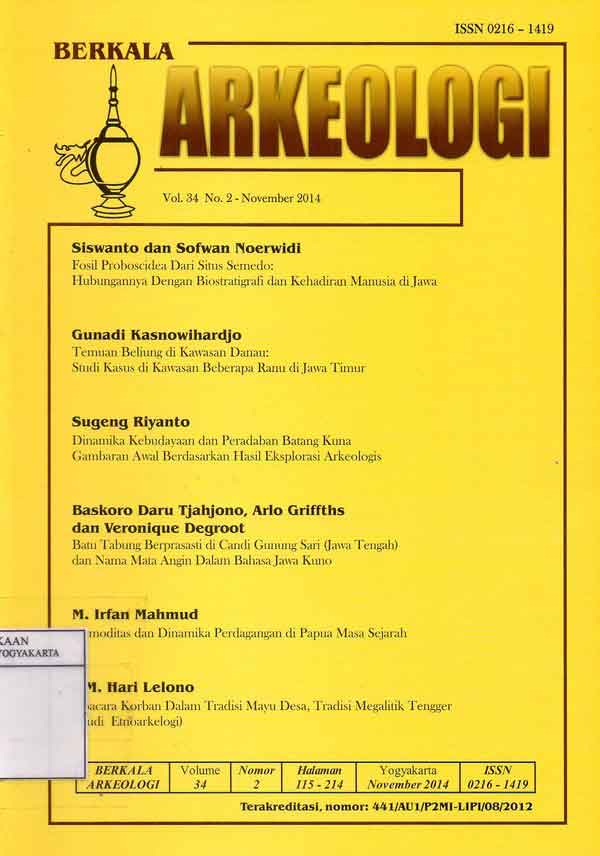FOSIL PROBOSCIDEA DARI SITUS SEMEDO: HUBUNGANNYA DENGAN BIOSTRATIGRAFI DAN KEHADIRAN MANUSIA DI JAWA
Main Article Content
Abstract
Semedo site is rich on vertebrate fossils, with huge percentage come from Ordo Proboscidea. The aim of this paper is to identify the taxonomy of Proboscidean fossils important for reconstruction on Biostratigraphy of Java. This research uses a descriptive comparative method on morphological and morphometry characters, compared to similar data from Java and others related places. Based on this research we know that in Semedo site there are several species of Proboscidean, i.e.: Sinomastodon bumiayuensis, Stegodon trigonocephalus, Stegodon â€pygmy†semedoensis, Stegodon hypsilophus, Elephas (Archidiskodon) planifrons, and Elephas Hysudrindicus. This reflects that a long environmental changes or the history of ancient environment has been recorded in Semedo, related with ecological context of hominid appearance in this region.
Article Details

This work is licensed under a Creative Commons Attribution-NonCommercial-ShareAlike 4.0 International License.
References
Alberdi M.T., J.L. Prado, E. Ortiz-Jaureguizar, P. Posadas dan M. Donato. 2007. “Historical Biogeography of Trilophodont Gomphotheres (Mammalia, Proboscidea): Reconstructed Applying Dispersion-Vicariance Analysis†dalam E. DÃaz-MartÃnez e I. Rábano (ed.) 4th European Meeting on the Palaeontology and Stratigraphy of Latin America Cuadernos del Museo Geominero, No 8. Madrid: Instituto Geológico y Minero de España. Hlm. 9-14.
van den Bergh, G.D., J. de Vos, P.Y. Sondaar dan F. Aziz. 1996. â€Pleistocene zoogeographic evolution of Java (Indonesia) and glacio-eustatic sea-level fluctuations: a background for the presence of Homo†dalam Indo-Pacific Prehist. Assoc. Bull., 14 (Chiang Mai Papers, 1). Hlm. 7-21.
van den Bergh, G. D. 1999. “The Late Neogene elephantoid-bearing faunas of Indonesia and their palaeozoogeographic implications. A study of the terrestrial faunal succession of Sulawesi, Flores and Java, including evidence for early hominid dispersal east of Wallace's line†dalam Scripta Geol., 117. Leiden: National Natuurhistorisch Museum.
van Essen H., van den Bergh G. dan de Vos J. 2006. â€The final solution of the Cryptomastodon problem. Morphological correlations between supernumerary teeth in stegodonts and elephants (Proboscidea, Mammalia)†dalam Courier Forschungsinstitut Senckenberg, 256. Hlm. 29-41.
Hooijer, D.A., 1954. “A Pygmy Stegodon from the Middle Pleistocene of Eastern Java†dalam Zool. Meded., 33. Leiden: Rijksmuseum van Natuurlijke Historie. Hlm. 91-102.
__________ 1955. “Fossil Proboscidea from the Malay Archipelago and India†dalam Zool. Verh., 28. Leiden: E.J. Brill.
__________ 1969. “The Stegodon from Timor†dalam Proc. Kon. Ned. Akad. Wet., B, 72, Amsterdam. Hlm. 201-210.
__________ 1984. “The solution of the Cryptomastodon problem†dalam Netherlands Journal of Zoology, 34(2). Hlm. 228-231.
Huffman, Frank O. 2001. “Geologic context and age of the Perning/Mojokerto Homo erectus, East Java†dalam Journal of Human Evolution 40 (2001). Hlm. 353–362.
von Koenigswald, G.H.R. 1933. “Beitrag zur Kenntnis der fossilen Wirbeltiere Javas†dalam Wet. Meded. Dienst Mijnbouw Ned.-Indië, 23. Batavia: Landsdrukkerij.
van der Maarel, F.H. 1932. “Contributions to the knowledge of the fossil mammalian fauna of Java†dalam Wet. Meded. Dienst Mijnbouw Ned.-Indië, 15. Batavia: Landsdrukkerij.
Maglio, V.J., 1973. “Origin and evolution of the Elephantidae†dalam Trans. Amer. Phil. Soc., N.S., 63, 3. Hlm. 1-149.
Sartono, S. 1969. “Stegodon timorensis: A Pygmy Specimen from Timor (Indonesia)†dalam Proc. Kon. Ned. Akad. Wet., B, 72, Amsterdam. Hlm. 192-200.
Shoshani, J., P. Tassy. 2005. “Advances in proboscidean taxonomy & classification, anatomy & physiology, and ecology & behavior†dalam Quaternary International 126–128 (2005). Hlm. 5–20.
Siswanto, et.al. 2013. “Penelitian Manusia, Budaya, dan Lingkungan pada Kala Plestosen di Situs Semedo, Kabupaten Tegal, Jawa Tengahâ€. Laporan Penelitian Arkeologi. Yogyakarta: Balai Arkeologi
Sondaar, P.Y., 1984. “Faunal evolution and the mammalian biostratigraphy of Java†dalam Cour. Forsch. Inst. Senckenberg, 69. Hlm. 219-235.
Tobien H, Chen G F, Li Y Q. 1986. â€Mastodonts (Proboscidea. Mammalia) from the late Neogene and early Pleistocene of the People’s Republic of China, Part 1†dalam Mainz Geowiss Mitt, 1986, 15. Hlm. 119-181.
de Vos, J. 1983. “The Pongo faunas from Java and Sumatra and their significance for biostratigraphical and paleo-ecological interpretations†dalam Proc. Kon. Ned. Akad. Wet., B, 86. Hlm. 417-425.
Wang, Yuan, Jin ChangZhu, Deng ChengLong, Wei GuangBiao, Yan YaLing. 2012. “The first Sinomastodon (Gomphotheriidae, Proboscidea) skull from the Quaternary in China†dalam Chin Sci Bull, 2012, 57. Hlm. 4726-4734.
Widianto, H. 2011. Nafas Sangiran, Nafas SItus-situs Hominid. Sragen: BPSMP Sangiran.
Widianto, H. dan M. Hidayat. 2006. “Semedo, Situs Baru Kehidupan Manusia Purba pada Kala Plestosenâ€. Berita Penelitian Arkeologi No. 21. Yogyakarta: Balai Arkeologi.
Widiyanta, W. dan M. Hidayat. 2012. â€Penelitian Homo erectus SItus Semedo: Umur, Budaya dan Lingkunganâ€. Laporan Eksplorasi. Sragen: BPSMP Sangiran
Zaim, Yahdi. 2004. “A New Discovery of Stegodon in Early Pleistocene Sediments from the Sumedang Area (West Java, Indonesia†dalam 18th International Senckenberg Conference. Weimar.
www.pemkabtegal.go.id

